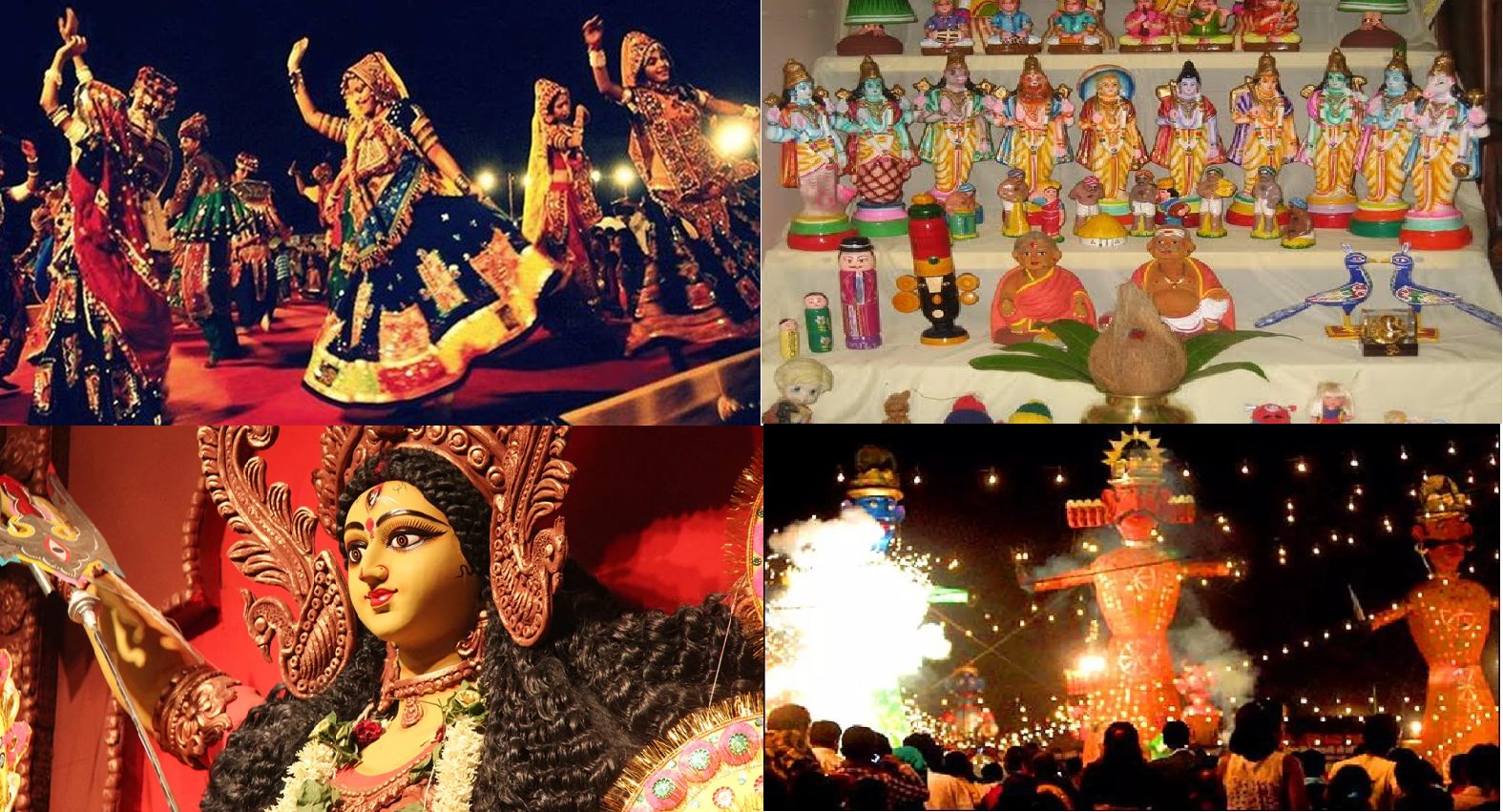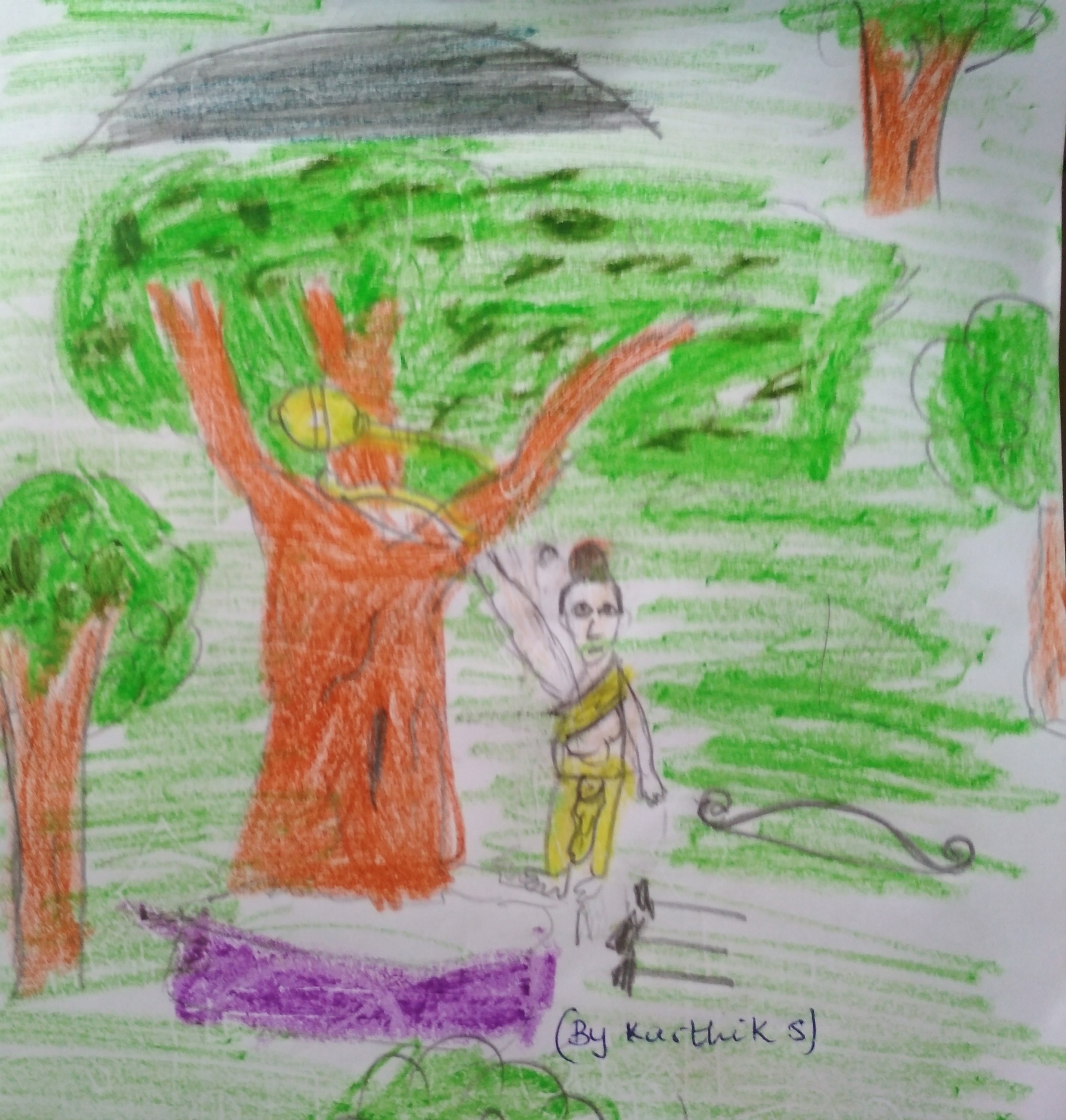Festivals are a great time to introduce children to fascinating legends and stories that abound all across India. And quite often, they become starting points to discover much more about the country, it’s history and its culture.
Navratri and Dussera are celebrated across India in various ways.
Garbha and Dandiya in the west.
Durga Puja in the east.
Golu in the south.
Ram Leela in the north.
Diverse ways of bringing in the same festival.

Anthropologists like E.B. Tylor and James Fraser, who studied ritual practices, wrote about how myths and rituals are intimately connected, one arising from the other, pioneering what is known as the Myth-Ritual Theory
Put in simple words, this view suggests that every ritual has a corresponding myth.
While this is contested by other theorists, it is an interesting starting point to look for connecting tales that form the bedrock of some of the Dussera rituals. Let’s look at Ayudha Puja (Worship of Implements) that is observed on Vijaydashmi Day.
Ayudha Puja/Worship if Implements
As a child, I have vivid memories of my grandmother and mother asking everybody at home to place before the goddess all that one uses in their profession. So my mother (a musician) would place her Veena, my father and aunt (both lawyers) would place some of their legal books and I would keep my school books on a platform before the alter. Having gathered all these the night, on the morning of Dussera, we’d wake up early, bathe and then worship the implements before reading from the books/playing the instruments.
Later when I began working, I noticed that the ritual was common not just in homes but in offices and factories too. Officers, clerks, workers – they all routinely pulled out the tools used in their vocation and worshiped them on this day.
When my son noticed my mother worshiping her music instruments and performing the Puja at Vijaydashmi last year, he asked me why that was being done and more so, why on that particular day. As is often the case, it was a question from my children that made me prod on.

Connecting Myth with Ritual
Given the Ritual and the Myth-Ritual theory, how about trying to trace the ritual in myth?
The answer led me to my all-time favourite story – the evergreen and dynamic Mahabharata.
In the Epic, after the game of dice when the Pandavas lose their kingdom, they are forced into exile and are required to spend the last year of exile incognito. This is when they all take on various disguises to remain hidden.
Before they leave for their exile, they hide their weapons in a safe place so that they are able to retrieve them at a later point in time. The place they choose to hide their weapons is a Shami Tree in a jungle.
Later, when the war is about to begin, Arjuna, returns to the Shami tree to take back his weapons. Removing the bundle from the tree carefully, Arjuna cleans the weapons and worships them, before marching on to the battlefield at Kurukshetra for the war.

The Pandavas win the 18 day war – that day is Vijaydashmi (the day is also marked as the victory of Durga over Mahishasura and Rama over Ravana).
The legend of Arjuna and his worship of the weapons retrieved from the Shami tree before marching on for battle is linked to the ritual of the Ayudha Puja performed on the day of Vijaydashmi.
On a separate note, the tree in which Arjuna hides his weapons is the Shami Tree, also known as Khejarli and is the State Tree of Rajasthan. For another fascinating story about this tree – Read They Died to Save Trees – an interesting historical legend from Jodhpur.

An Ode to Tools
A line, famous in History Books, is ‘Man is a tool making animal‘ . A statement attributed to Benjamin Franklin.

And if one gave it some thought, one would realize that, that little sentence contains much truth.
One of the fundamental ways in which humans differ from other animals is in their ability to fashion tools (from the simple screw-driver and hammer to the sophisticated robot and mobile phone), and make use of them to alter the natural conditions around them. This helps them to adapt and survive.

When one studies anthropology and history, one learns that the earliest caveman began using tools such as flint stones to create fire, to make weapons and hunt animals and to do a range of other things through which humans gained an advantage over other species (that did not make tools).
Tools therefore, are a fundamental element of how human beings have evolved and survived through the ages.

Coming to think of it, tool-making is quite a remarkable thing.
Ayudha Puja, a ritual conducted in Indian homes, offices and factories across the country during Dussera, is a fascinating ritual seen in light of this.
Where one remembers to pay obeisance to humble tools – made of metal/paper/wood/ whatever the case may be – without which one could not have achieved all that they wanted to.

Drill and hammer to a carpenter, paint and canvas to an artist, tabla and harmonium to a musician, paper and pen to a writer – they form the substratum to human creativity and livelihood .
Tools are indeed game-changers in the human march towards civilization.
I cannot help but note that a special day to give these implements some rest, give them the honour they deserve and worship them, is a wonderful gesture.
So this Dusshera, whether you perform the Ayudha Puja or not, take some time to narrate the story of Arjuna and the historical significance of tool-making to your children – so they may see these practices not just as empty and meaningless rituals – but understand why they may have begun and why they continue to be practiced.
Some tips : Connecting History and Mythology to the world around you, helps make it a living subject for children. You can use this story to discuss with your children
- IDEAS : What other rituals can you connect with myths? What could their basis have been?
- MYTHOLOGY : Navratri and Dussera – what are the various rituals and what are the associated myths?
- HISTORY : Tool Making and its role in Human Civilization
- FESTIVALS IN INDIA : How is Dussera celebrated in different parts of India
SIGN UP TO THE MONTHLY NEWSLETTER
As I said, Festivals are a great time to introduce children to India and its various legends and myths. And that becomes a window to explore much more!
Happy Learning and Happy Dussera!
Interested in some more stories related to festivals? These posts might interest you
- Interested in making Indian History and Culture more interesting and relevant for Children? Stay tuned by subscribing to the Site Newsletter!
,

Samidha Dhongade
October 18, 2018 - 7:02 am ·Very interesting… Good way to explain to kids about ayudha puja…
Mallika Ravikumar
October 18, 2018 - 7:06 am ·Thank you Samidha!
calliphilis
October 18, 2018 - 8:03 am ·Very well written as usual, Mallika! I appreciate your contextualizing the rituals with multiple references from epics, regions and formal theories.
About the aayudha-pooja, one reason my baba had given me was that this was a good opportunity for an annual check-up and overhauling of the instruments, especially those related to agriculture. In our urban context, it could mean a thorough servicing of automated vehicles and bicycles, getting the gas burners cleaned out, getting sports and musical equipment shaped up, books catalogued and covered ?
Mallika Ravikumar
October 18, 2018 - 9:21 am ·Thanks Gayatri. That’s a good point …it’s a good time to get things serviced. Didn’t think of this. Interesting.
kalpanabshaw
October 18, 2018 - 8:51 am ·Very eloquently written. Infact the Vishavkarma Pooja ( Vishavkarma, the architect God.) celebrated at different times across different part is a similar Pooja with a different name. I remember in my father’s Fertilizer plant the Pooja was done at a grand scale and tilak was applied to every single machine. Everyone worshiped their tools. Inereting would try and find out the myth and the story behind it.
Mallika Ravikumar
October 18, 2018 - 9:20 am ·Thanks Kalpana. Yes.. i too have seen how in factories they celebrate in a big way. 🙂